Design Research: Australian Culture, Identity, and Design Objects
VerifiedAdded on 2023/03/30
|9
|2020
|262
Report
AI Summary
This report delves into the realm of design research, focusing on the multifaceted aspects of Australian culture and identity. It begins by exploring the formation of a multicultural society in Australia, highlighting the integration of diverse cultural groups and the evolution of Australian identity, emphasizing concepts such as mateship and egalitarianism. The report then transitions to an analysis of specific Australian design objects, namely the KeepCup and box wine. The KeepCup is examined as a design object that has become a cultural icon, reflecting a shift towards environmental consciousness and sustainable practices within Australian society. The analysis covers the KeepCup's design, consumer behavior, and its impact on reducing waste. The report also examines box wine and its impact on Australian culture. It explores the product's appeal, the rise of wine consumption, and the associated health concerns. Overall, the report provides insights into the dynamic relationship between design, culture, and identity in Australia, showcasing how everyday objects can reflect and shape societal values and behaviors.
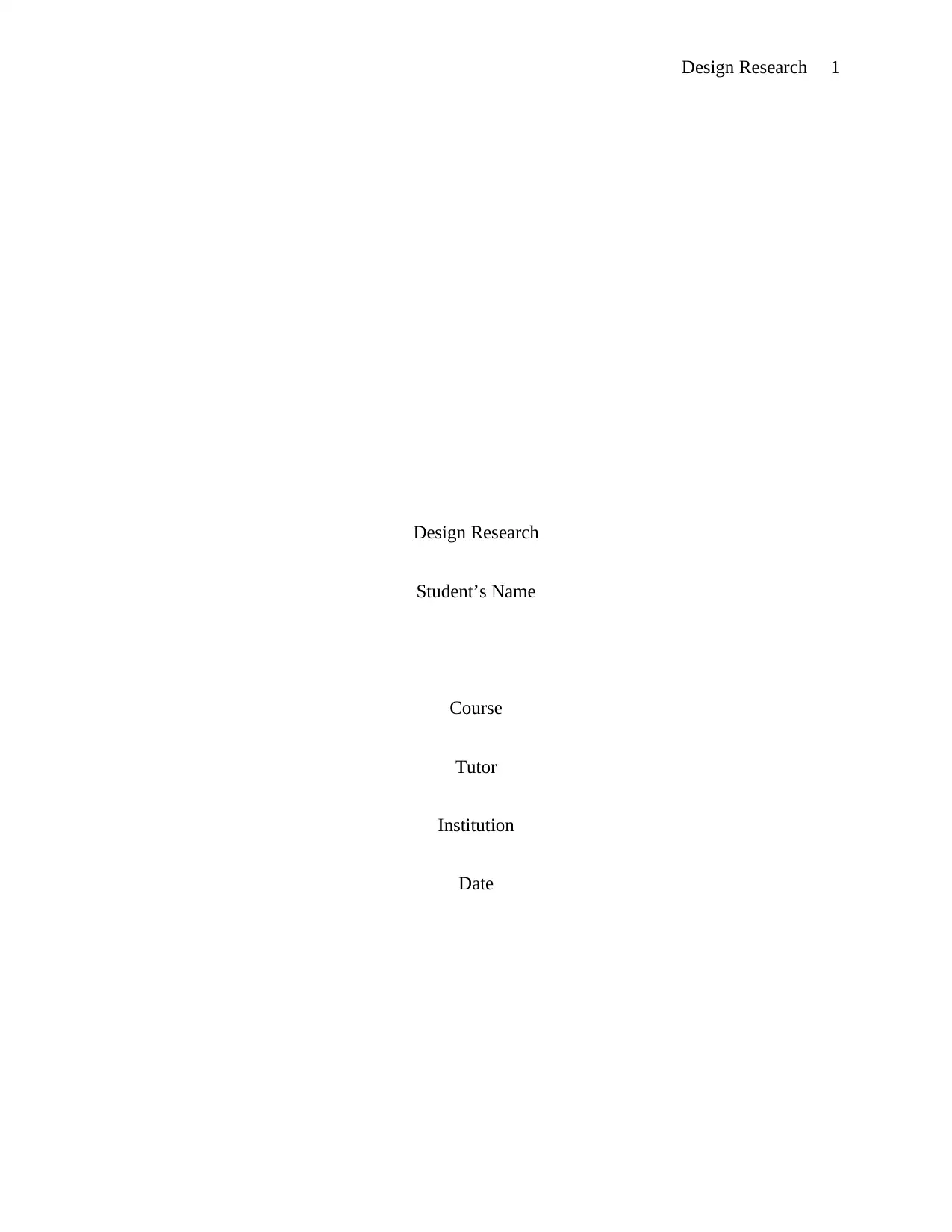
Design Research 1
Design Research
Student’s Name
Course
Tutor
Institution
Date
Design Research
Student’s Name
Course
Tutor
Institution
Date
Paraphrase This Document
Need a fresh take? Get an instant paraphrase of this document with our AI Paraphraser
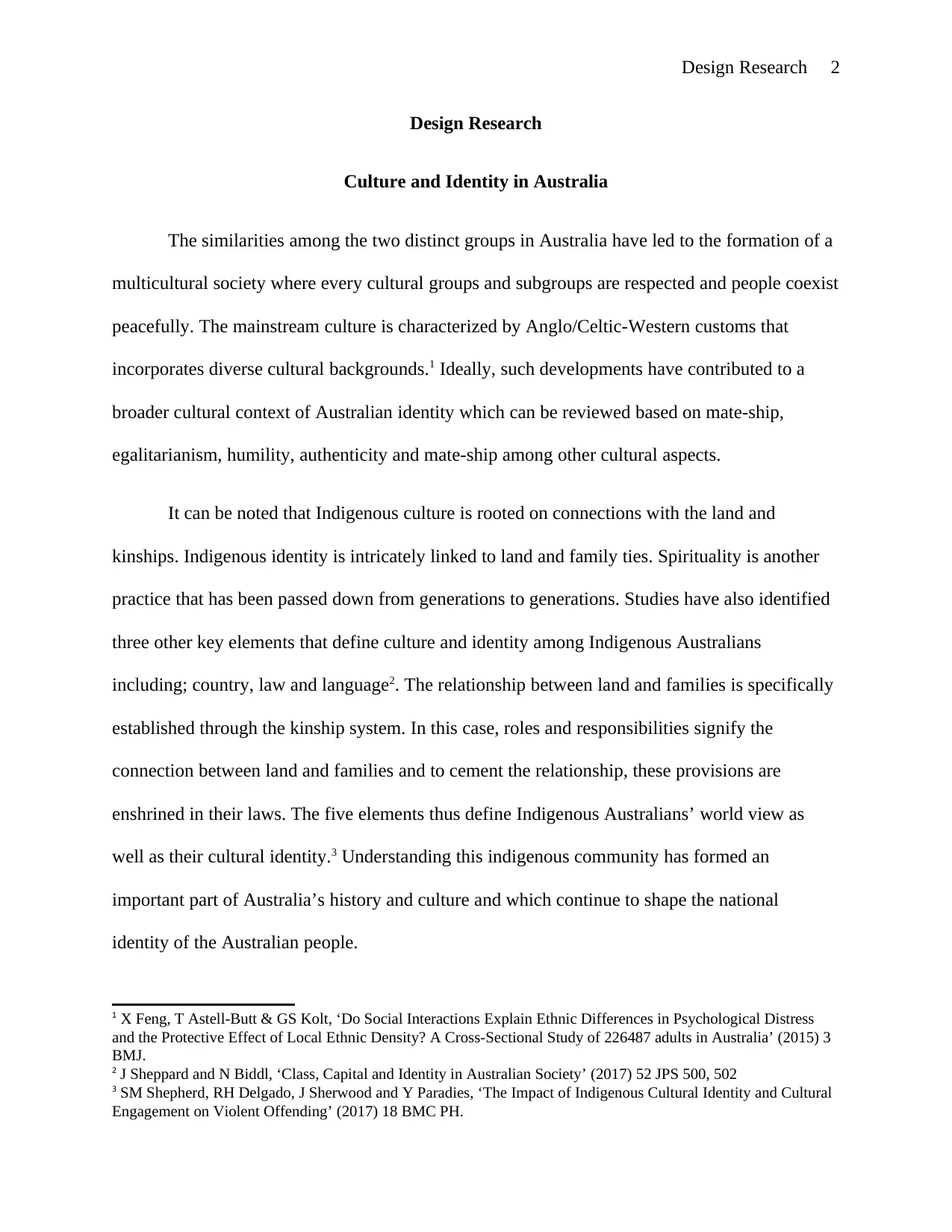
Design Research 2
Design Research
Culture and Identity in Australia
The similarities among the two distinct groups in Australia have led to the formation of a
multicultural society where every cultural groups and subgroups are respected and people coexist
peacefully. The mainstream culture is characterized by Anglo/Celtic-Western customs that
incorporates diverse cultural backgrounds.1 Ideally, such developments have contributed to a
broader cultural context of Australian identity which can be reviewed based on mate-ship,
egalitarianism, humility, authenticity and mate-ship among other cultural aspects.
It can be noted that Indigenous culture is rooted on connections with the land and
kinships. Indigenous identity is intricately linked to land and family ties. Spirituality is another
practice that has been passed down from generations to generations. Studies have also identified
three other key elements that define culture and identity among Indigenous Australians
including; country, law and language2. The relationship between land and families is specifically
established through the kinship system. In this case, roles and responsibilities signify the
connection between land and families and to cement the relationship, these provisions are
enshrined in their laws. The five elements thus define Indigenous Australians’ world view as
well as their cultural identity.3 Understanding this indigenous community has formed an
important part of Australia’s history and culture and which continue to shape the national
identity of the Australian people.
1 X Feng, T Astell-Butt & GS Kolt, ‘Do Social Interactions Explain Ethnic Differences in Psychological Distress
and the Protective Effect of Local Ethnic Density? A Cross-Sectional Study of 226487 adults in Australia’ (2015) 3
BMJ.
2 J Sheppard and N Biddl, ‘Class, Capital and Identity in Australian Society’ (2017) 52 JPS 500, 502
3 SM Shepherd, RH Delgado, J Sherwood and Y Paradies, ‘The Impact of Indigenous Cultural Identity and Cultural
Engagement on Violent Offending’ (2017) 18 BMC PH.
Design Research
Culture and Identity in Australia
The similarities among the two distinct groups in Australia have led to the formation of a
multicultural society where every cultural groups and subgroups are respected and people coexist
peacefully. The mainstream culture is characterized by Anglo/Celtic-Western customs that
incorporates diverse cultural backgrounds.1 Ideally, such developments have contributed to a
broader cultural context of Australian identity which can be reviewed based on mate-ship,
egalitarianism, humility, authenticity and mate-ship among other cultural aspects.
It can be noted that Indigenous culture is rooted on connections with the land and
kinships. Indigenous identity is intricately linked to land and family ties. Spirituality is another
practice that has been passed down from generations to generations. Studies have also identified
three other key elements that define culture and identity among Indigenous Australians
including; country, law and language2. The relationship between land and families is specifically
established through the kinship system. In this case, roles and responsibilities signify the
connection between land and families and to cement the relationship, these provisions are
enshrined in their laws. The five elements thus define Indigenous Australians’ world view as
well as their cultural identity.3 Understanding this indigenous community has formed an
important part of Australia’s history and culture and which continue to shape the national
identity of the Australian people.
1 X Feng, T Astell-Butt & GS Kolt, ‘Do Social Interactions Explain Ethnic Differences in Psychological Distress
and the Protective Effect of Local Ethnic Density? A Cross-Sectional Study of 226487 adults in Australia’ (2015) 3
BMJ.
2 J Sheppard and N Biddl, ‘Class, Capital and Identity in Australian Society’ (2017) 52 JPS 500, 502
3 SM Shepherd, RH Delgado, J Sherwood and Y Paradies, ‘The Impact of Indigenous Cultural Identity and Cultural
Engagement on Violent Offending’ (2017) 18 BMC PH.
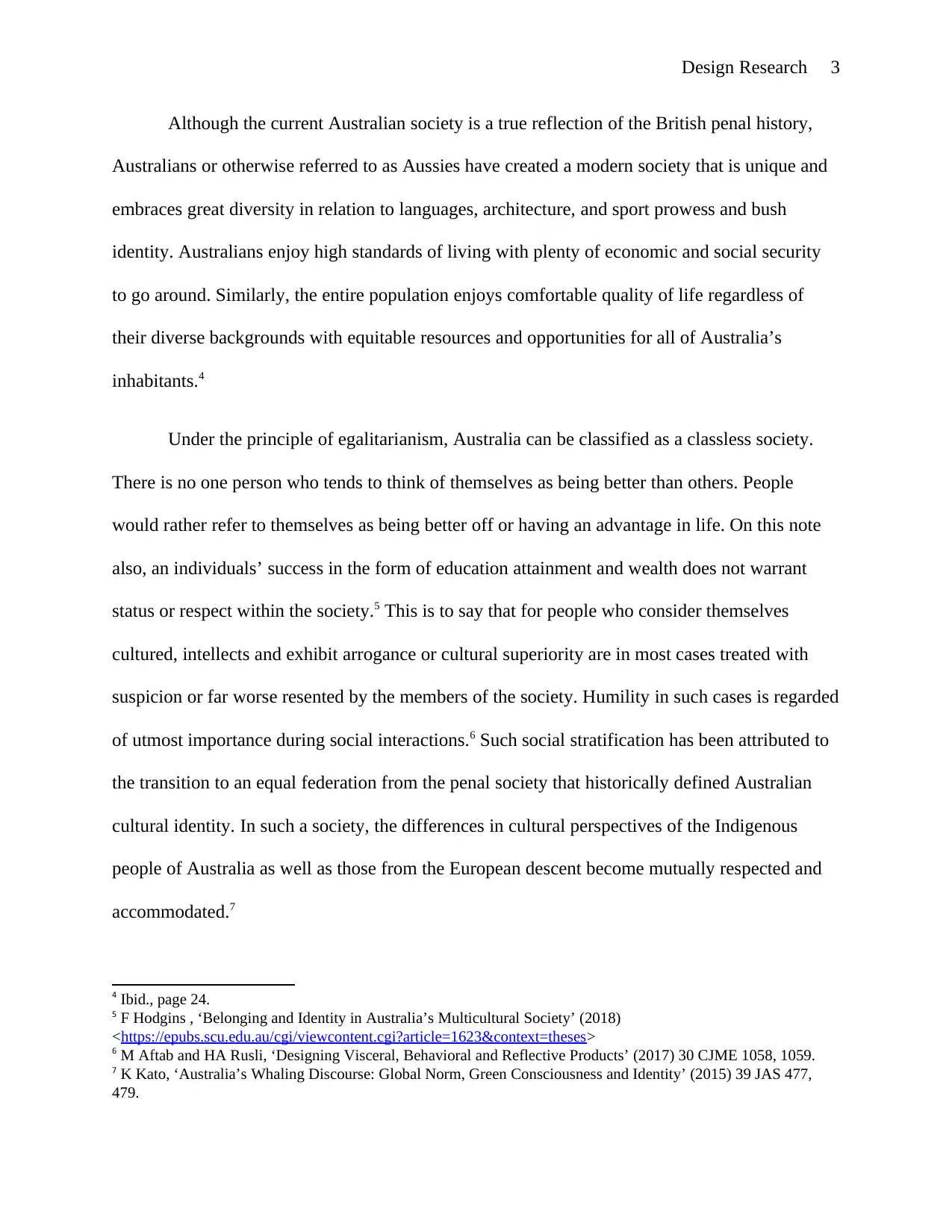
Design Research 3
Although the current Australian society is a true reflection of the British penal history,
Australians or otherwise referred to as Aussies have created a modern society that is unique and
embraces great diversity in relation to languages, architecture, and sport prowess and bush
identity. Australians enjoy high standards of living with plenty of economic and social security
to go around. Similarly, the entire population enjoys comfortable quality of life regardless of
their diverse backgrounds with equitable resources and opportunities for all of Australia’s
inhabitants.4
Under the principle of egalitarianism, Australia can be classified as a classless society.
There is no one person who tends to think of themselves as being better than others. People
would rather refer to themselves as being better off or having an advantage in life. On this note
also, an individuals’ success in the form of education attainment and wealth does not warrant
status or respect within the society.5 This is to say that for people who consider themselves
cultured, intellects and exhibit arrogance or cultural superiority are in most cases treated with
suspicion or far worse resented by the members of the society. Humility in such cases is regarded
of utmost importance during social interactions.6 Such social stratification has been attributed to
the transition to an equal federation from the penal society that historically defined Australian
cultural identity. In such a society, the differences in cultural perspectives of the Indigenous
people of Australia as well as those from the European descent become mutually respected and
accommodated.7
4 Ibid., page 24.
5 F Hodgins , ‘Belonging and Identity in Australia’s Multicultural Society’ (2018)
<https://epubs.scu.edu.au/cgi/viewcontent.cgi?article=1623&context=theses>
6 M Aftab and HA Rusli, ‘Designing Visceral, Behavioral and Reflective Products’ (2017) 30 CJME 1058, 1059.
7 K Kato, ‘Australia’s Whaling Discourse: Global Norm, Green Consciousness and Identity’ (2015) 39 JAS 477,
479.
Although the current Australian society is a true reflection of the British penal history,
Australians or otherwise referred to as Aussies have created a modern society that is unique and
embraces great diversity in relation to languages, architecture, and sport prowess and bush
identity. Australians enjoy high standards of living with plenty of economic and social security
to go around. Similarly, the entire population enjoys comfortable quality of life regardless of
their diverse backgrounds with equitable resources and opportunities for all of Australia’s
inhabitants.4
Under the principle of egalitarianism, Australia can be classified as a classless society.
There is no one person who tends to think of themselves as being better than others. People
would rather refer to themselves as being better off or having an advantage in life. On this note
also, an individuals’ success in the form of education attainment and wealth does not warrant
status or respect within the society.5 This is to say that for people who consider themselves
cultured, intellects and exhibit arrogance or cultural superiority are in most cases treated with
suspicion or far worse resented by the members of the society. Humility in such cases is regarded
of utmost importance during social interactions.6 Such social stratification has been attributed to
the transition to an equal federation from the penal society that historically defined Australian
cultural identity. In such a society, the differences in cultural perspectives of the Indigenous
people of Australia as well as those from the European descent become mutually respected and
accommodated.7
4 Ibid., page 24.
5 F Hodgins , ‘Belonging and Identity in Australia’s Multicultural Society’ (2018)
<https://epubs.scu.edu.au/cgi/viewcontent.cgi?article=1623&context=theses>
6 M Aftab and HA Rusli, ‘Designing Visceral, Behavioral and Reflective Products’ (2017) 30 CJME 1058, 1059.
7 K Kato, ‘Australia’s Whaling Discourse: Global Norm, Green Consciousness and Identity’ (2015) 39 JAS 477,
479.
⊘ This is a preview!⊘
Do you want full access?
Subscribe today to unlock all pages.

Trusted by 1+ million students worldwide
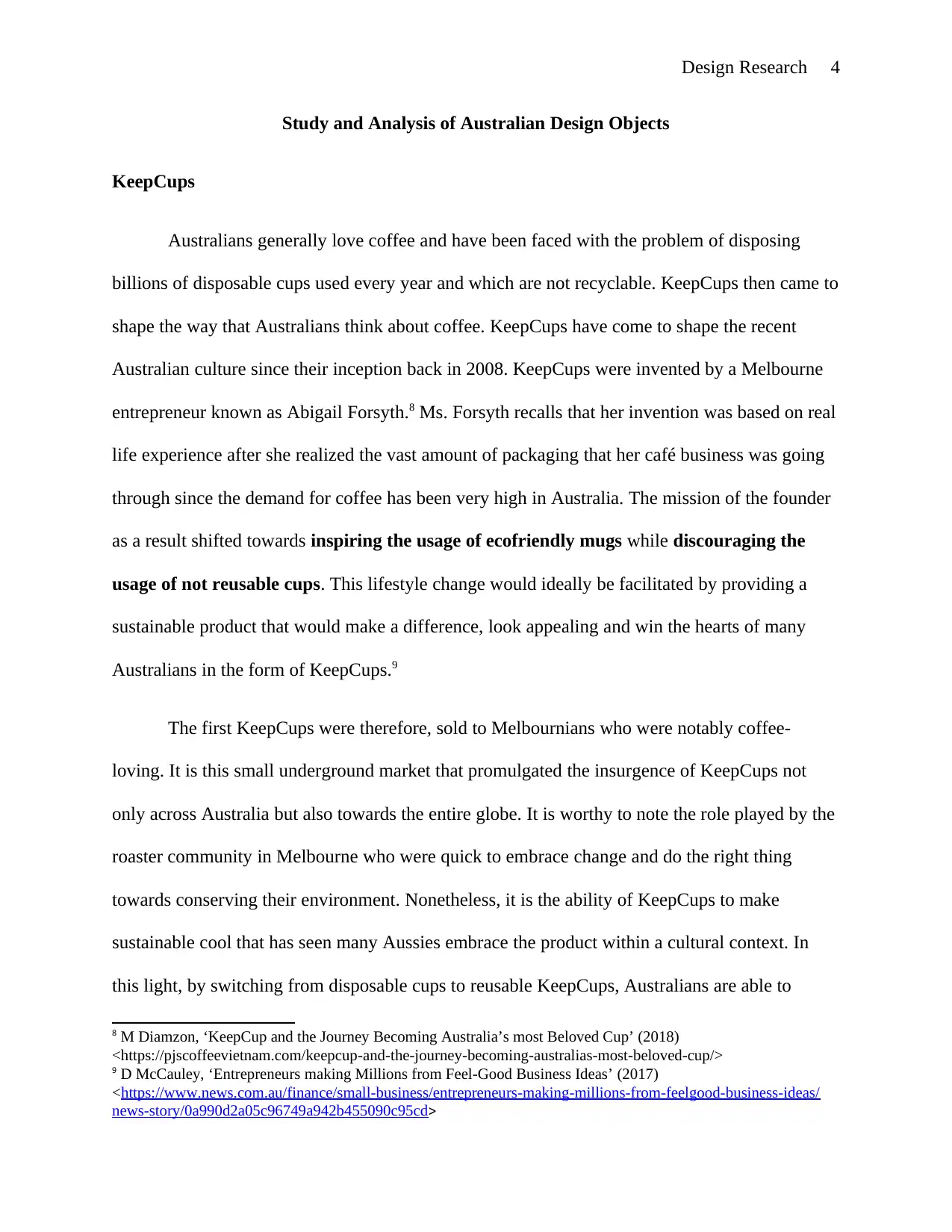
Design Research 4
Study and Analysis of Australian Design Objects
KeepCups
Australians generally love coffee and have been faced with the problem of disposing
billions of disposable cups used every year and which are not recyclable. KeepCups then came to
shape the way that Australians think about coffee. KeepCups have come to shape the recent
Australian culture since their inception back in 2008. KeepCups were invented by a Melbourne
entrepreneur known as Abigail Forsyth.8 Ms. Forsyth recalls that her invention was based on real
life experience after she realized the vast amount of packaging that her café business was going
through since the demand for coffee has been very high in Australia. The mission of the founder
as a result shifted towards inspiring the usage of ecofriendly mugs while discouraging the
usage of not reusable cups. This lifestyle change would ideally be facilitated by providing a
sustainable product that would make a difference, look appealing and win the hearts of many
Australians in the form of KeepCups.9
The first KeepCups were therefore, sold to Melbournians who were notably coffee-
loving. It is this small underground market that promulgated the insurgence of KeepCups not
only across Australia but also towards the entire globe. It is worthy to note the role played by the
roaster community in Melbourne who were quick to embrace change and do the right thing
towards conserving their environment. Nonetheless, it is the ability of KeepCups to make
sustainable cool that has seen many Aussies embrace the product within a cultural context. In
this light, by switching from disposable cups to reusable KeepCups, Australians are able to
8 M Diamzon, ‘KeepCup and the Journey Becoming Australia’s most Beloved Cup’ (2018)
<https://pjscoffeevietnam.com/keepcup-and-the-journey-becoming-australias-most-beloved-cup/>
9 D McCauley, ‘Entrepreneurs making Millions from Feel-Good Business Ideas’ (2017)
<https://www.news.com.au/finance/small-business/entrepreneurs-making-millions-from-feelgood-business-ideas/
news-story/0a990d2a05c96749a942b455090c95cd>
Study and Analysis of Australian Design Objects
KeepCups
Australians generally love coffee and have been faced with the problem of disposing
billions of disposable cups used every year and which are not recyclable. KeepCups then came to
shape the way that Australians think about coffee. KeepCups have come to shape the recent
Australian culture since their inception back in 2008. KeepCups were invented by a Melbourne
entrepreneur known as Abigail Forsyth.8 Ms. Forsyth recalls that her invention was based on real
life experience after she realized the vast amount of packaging that her café business was going
through since the demand for coffee has been very high in Australia. The mission of the founder
as a result shifted towards inspiring the usage of ecofriendly mugs while discouraging the
usage of not reusable cups. This lifestyle change would ideally be facilitated by providing a
sustainable product that would make a difference, look appealing and win the hearts of many
Australians in the form of KeepCups.9
The first KeepCups were therefore, sold to Melbournians who were notably coffee-
loving. It is this small underground market that promulgated the insurgence of KeepCups not
only across Australia but also towards the entire globe. It is worthy to note the role played by the
roaster community in Melbourne who were quick to embrace change and do the right thing
towards conserving their environment. Nonetheless, it is the ability of KeepCups to make
sustainable cool that has seen many Aussies embrace the product within a cultural context. In
this light, by switching from disposable cups to reusable KeepCups, Australians are able to
8 M Diamzon, ‘KeepCup and the Journey Becoming Australia’s most Beloved Cup’ (2018)
<https://pjscoffeevietnam.com/keepcup-and-the-journey-becoming-australias-most-beloved-cup/>
9 D McCauley, ‘Entrepreneurs making Millions from Feel-Good Business Ideas’ (2017)
<https://www.news.com.au/finance/small-business/entrepreneurs-making-millions-from-feelgood-business-ideas/
news-story/0a990d2a05c96749a942b455090c95cd>
Paraphrase This Document
Need a fresh take? Get an instant paraphrase of this document with our AI Paraphraser
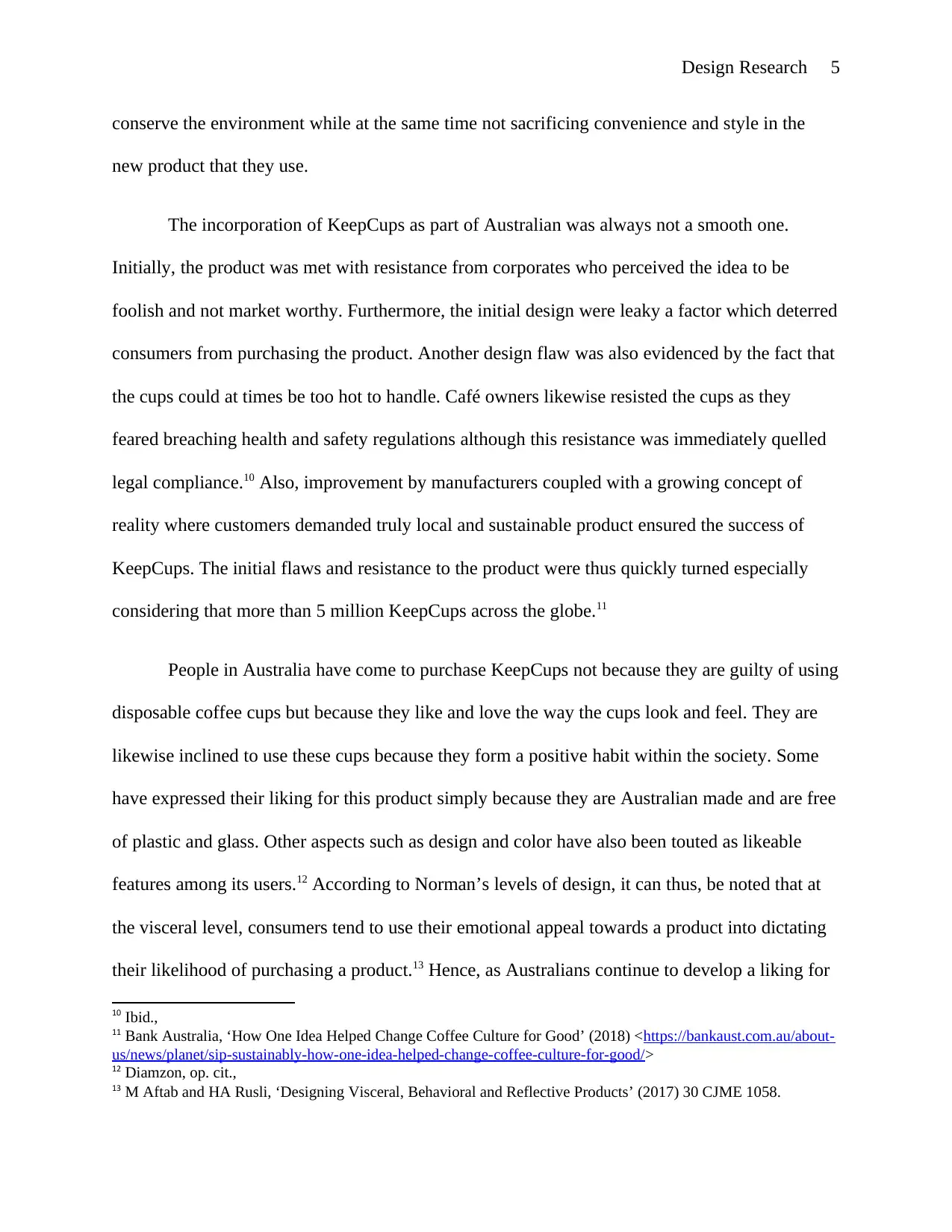
Design Research 5
conserve the environment while at the same time not sacrificing convenience and style in the
new product that they use.
The incorporation of KeepCups as part of Australian was always not a smooth one.
Initially, the product was met with resistance from corporates who perceived the idea to be
foolish and not market worthy. Furthermore, the initial design were leaky a factor which deterred
consumers from purchasing the product. Another design flaw was also evidenced by the fact that
the cups could at times be too hot to handle. Café owners likewise resisted the cups as they
feared breaching health and safety regulations although this resistance was immediately quelled
legal compliance.10 Also, improvement by manufacturers coupled with a growing concept of
reality where customers demanded truly local and sustainable product ensured the success of
KeepCups. The initial flaws and resistance to the product were thus quickly turned especially
considering that more than 5 million KeepCups across the globe.11
People in Australia have come to purchase KeepCups not because they are guilty of using
disposable coffee cups but because they like and love the way the cups look and feel. They are
likewise inclined to use these cups because they form a positive habit within the society. Some
have expressed their liking for this product simply because they are Australian made and are free
of plastic and glass. Other aspects such as design and color have also been touted as likeable
features among its users.12 According to Norman’s levels of design, it can thus, be noted that at
the visceral level, consumers tend to use their emotional appeal towards a product into dictating
their likelihood of purchasing a product.13 Hence, as Australians continue to develop a liking for
10 Ibid.,
11 Bank Australia, ‘How One Idea Helped Change Coffee Culture for Good’ (2018) <https://bankaust.com.au/about-
us/news/planet/sip-sustainably-how-one-idea-helped-change-coffee-culture-for-good/>
12 Diamzon, op. cit.,
13 M Aftab and HA Rusli, ‘Designing Visceral, Behavioral and Reflective Products’ (2017) 30 CJME 1058.
conserve the environment while at the same time not sacrificing convenience and style in the
new product that they use.
The incorporation of KeepCups as part of Australian was always not a smooth one.
Initially, the product was met with resistance from corporates who perceived the idea to be
foolish and not market worthy. Furthermore, the initial design were leaky a factor which deterred
consumers from purchasing the product. Another design flaw was also evidenced by the fact that
the cups could at times be too hot to handle. Café owners likewise resisted the cups as they
feared breaching health and safety regulations although this resistance was immediately quelled
legal compliance.10 Also, improvement by manufacturers coupled with a growing concept of
reality where customers demanded truly local and sustainable product ensured the success of
KeepCups. The initial flaws and resistance to the product were thus quickly turned especially
considering that more than 5 million KeepCups across the globe.11
People in Australia have come to purchase KeepCups not because they are guilty of using
disposable coffee cups but because they like and love the way the cups look and feel. They are
likewise inclined to use these cups because they form a positive habit within the society. Some
have expressed their liking for this product simply because they are Australian made and are free
of plastic and glass. Other aspects such as design and color have also been touted as likeable
features among its users.12 According to Norman’s levels of design, it can thus, be noted that at
the visceral level, consumers tend to use their emotional appeal towards a product into dictating
their likelihood of purchasing a product.13 Hence, as Australians continue to develop a liking for
10 Ibid.,
11 Bank Australia, ‘How One Idea Helped Change Coffee Culture for Good’ (2018) <https://bankaust.com.au/about-
us/news/planet/sip-sustainably-how-one-idea-helped-change-coffee-culture-for-good/>
12 Diamzon, op. cit.,
13 M Aftab and HA Rusli, ‘Designing Visceral, Behavioral and Reflective Products’ (2017) 30 CJME 1058.
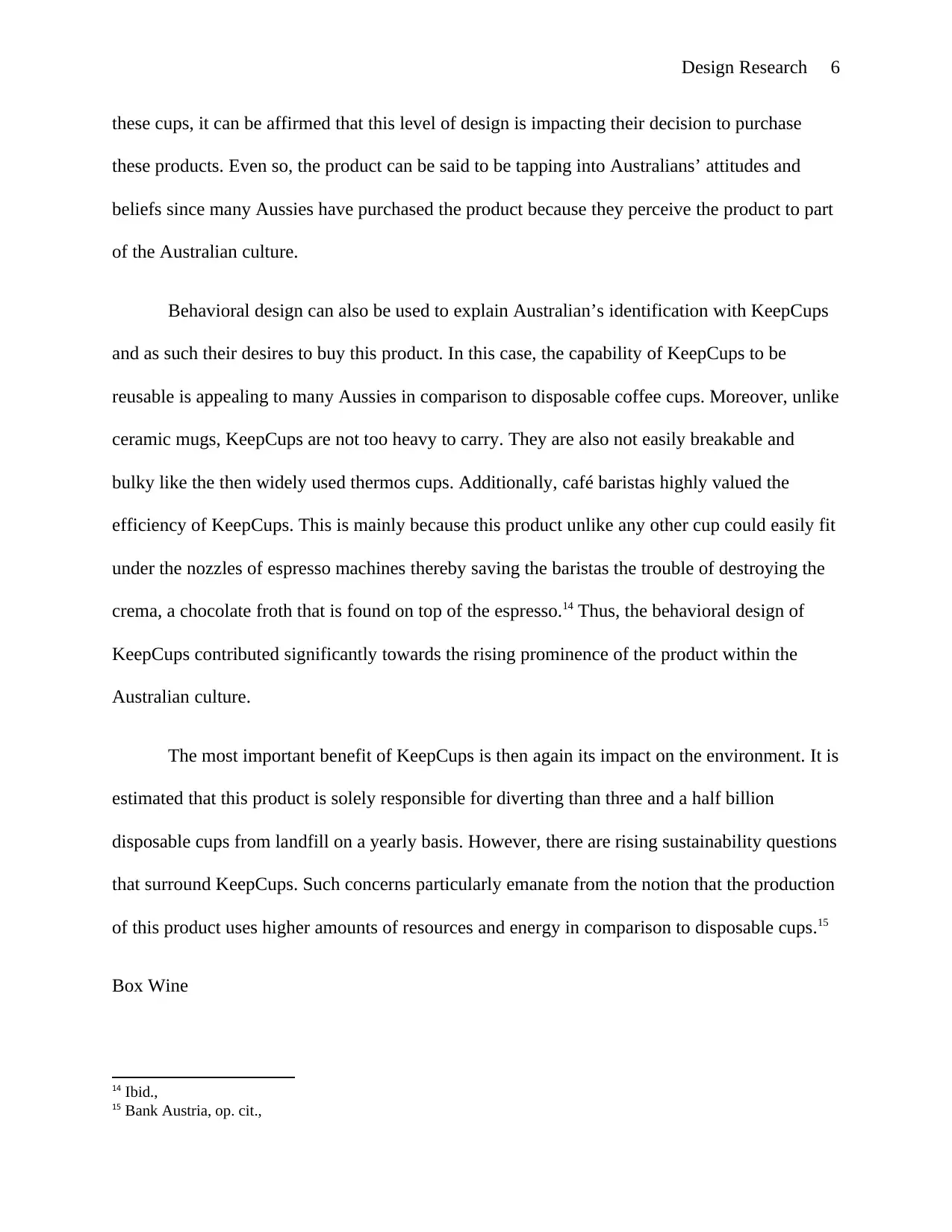
Design Research 6
these cups, it can be affirmed that this level of design is impacting their decision to purchase
these products. Even so, the product can be said to be tapping into Australians’ attitudes and
beliefs since many Aussies have purchased the product because they perceive the product to part
of the Australian culture.
Behavioral design can also be used to explain Australian’s identification with KeepCups
and as such their desires to buy this product. In this case, the capability of KeepCups to be
reusable is appealing to many Aussies in comparison to disposable coffee cups. Moreover, unlike
ceramic mugs, KeepCups are not too heavy to carry. They are also not easily breakable and
bulky like the then widely used thermos cups. Additionally, café baristas highly valued the
efficiency of KeepCups. This is mainly because this product unlike any other cup could easily fit
under the nozzles of espresso machines thereby saving the baristas the trouble of destroying the
crema, a chocolate froth that is found on top of the espresso.14 Thus, the behavioral design of
KeepCups contributed significantly towards the rising prominence of the product within the
Australian culture.
The most important benefit of KeepCups is then again its impact on the environment. It is
estimated that this product is solely responsible for diverting than three and a half billion
disposable cups from landfill on a yearly basis. However, there are rising sustainability questions
that surround KeepCups. Such concerns particularly emanate from the notion that the production
of this product uses higher amounts of resources and energy in comparison to disposable cups.15
Box Wine
14 Ibid.,
15 Bank Austria, op. cit.,
these cups, it can be affirmed that this level of design is impacting their decision to purchase
these products. Even so, the product can be said to be tapping into Australians’ attitudes and
beliefs since many Aussies have purchased the product because they perceive the product to part
of the Australian culture.
Behavioral design can also be used to explain Australian’s identification with KeepCups
and as such their desires to buy this product. In this case, the capability of KeepCups to be
reusable is appealing to many Aussies in comparison to disposable coffee cups. Moreover, unlike
ceramic mugs, KeepCups are not too heavy to carry. They are also not easily breakable and
bulky like the then widely used thermos cups. Additionally, café baristas highly valued the
efficiency of KeepCups. This is mainly because this product unlike any other cup could easily fit
under the nozzles of espresso machines thereby saving the baristas the trouble of destroying the
crema, a chocolate froth that is found on top of the espresso.14 Thus, the behavioral design of
KeepCups contributed significantly towards the rising prominence of the product within the
Australian culture.
The most important benefit of KeepCups is then again its impact on the environment. It is
estimated that this product is solely responsible for diverting than three and a half billion
disposable cups from landfill on a yearly basis. However, there are rising sustainability questions
that surround KeepCups. Such concerns particularly emanate from the notion that the production
of this product uses higher amounts of resources and energy in comparison to disposable cups.15
Box Wine
14 Ibid.,
15 Bank Austria, op. cit.,
⊘ This is a preview!⊘
Do you want full access?
Subscribe today to unlock all pages.

Trusted by 1+ million students worldwide
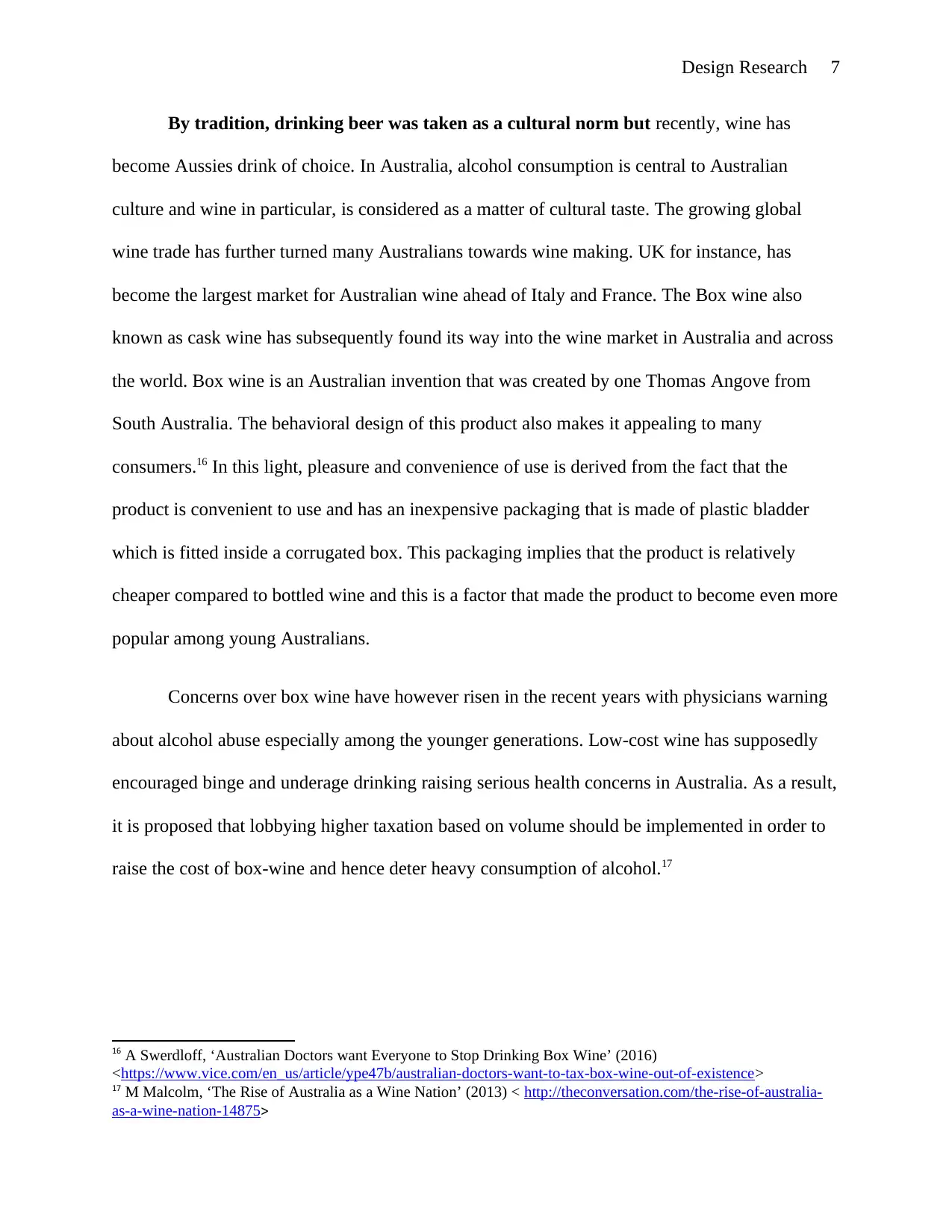
Design Research 7
By tradition, drinking beer was taken as a cultural norm but recently, wine has
become Aussies drink of choice. In Australia, alcohol consumption is central to Australian
culture and wine in particular, is considered as a matter of cultural taste. The growing global
wine trade has further turned many Australians towards wine making. UK for instance, has
become the largest market for Australian wine ahead of Italy and France. The Box wine also
known as cask wine has subsequently found its way into the wine market in Australia and across
the world. Box wine is an Australian invention that was created by one Thomas Angove from
South Australia. The behavioral design of this product also makes it appealing to many
consumers.16 In this light, pleasure and convenience of use is derived from the fact that the
product is convenient to use and has an inexpensive packaging that is made of plastic bladder
which is fitted inside a corrugated box. This packaging implies that the product is relatively
cheaper compared to bottled wine and this is a factor that made the product to become even more
popular among young Australians.
Concerns over box wine have however risen in the recent years with physicians warning
about alcohol abuse especially among the younger generations. Low-cost wine has supposedly
encouraged binge and underage drinking raising serious health concerns in Australia. As a result,
it is proposed that lobbying higher taxation based on volume should be implemented in order to
raise the cost of box-wine and hence deter heavy consumption of alcohol.17
16 A Swerdloff, ‘Australian Doctors want Everyone to Stop Drinking Box Wine’ (2016)
<https://www.vice.com/en_us/article/ype47b/australian-doctors-want-to-tax-box-wine-out-of-existence>
17 M Malcolm, ‘The Rise of Australia as a Wine Nation’ (2013) < http://theconversation.com/the-rise-of-australia-
as-a-wine-nation-14875>
By tradition, drinking beer was taken as a cultural norm but recently, wine has
become Aussies drink of choice. In Australia, alcohol consumption is central to Australian
culture and wine in particular, is considered as a matter of cultural taste. The growing global
wine trade has further turned many Australians towards wine making. UK for instance, has
become the largest market for Australian wine ahead of Italy and France. The Box wine also
known as cask wine has subsequently found its way into the wine market in Australia and across
the world. Box wine is an Australian invention that was created by one Thomas Angove from
South Australia. The behavioral design of this product also makes it appealing to many
consumers.16 In this light, pleasure and convenience of use is derived from the fact that the
product is convenient to use and has an inexpensive packaging that is made of plastic bladder
which is fitted inside a corrugated box. This packaging implies that the product is relatively
cheaper compared to bottled wine and this is a factor that made the product to become even more
popular among young Australians.
Concerns over box wine have however risen in the recent years with physicians warning
about alcohol abuse especially among the younger generations. Low-cost wine has supposedly
encouraged binge and underage drinking raising serious health concerns in Australia. As a result,
it is proposed that lobbying higher taxation based on volume should be implemented in order to
raise the cost of box-wine and hence deter heavy consumption of alcohol.17
16 A Swerdloff, ‘Australian Doctors want Everyone to Stop Drinking Box Wine’ (2016)
<https://www.vice.com/en_us/article/ype47b/australian-doctors-want-to-tax-box-wine-out-of-existence>
17 M Malcolm, ‘The Rise of Australia as a Wine Nation’ (2013) < http://theconversation.com/the-rise-of-australia-
as-a-wine-nation-14875>
Paraphrase This Document
Need a fresh take? Get an instant paraphrase of this document with our AI Paraphraser
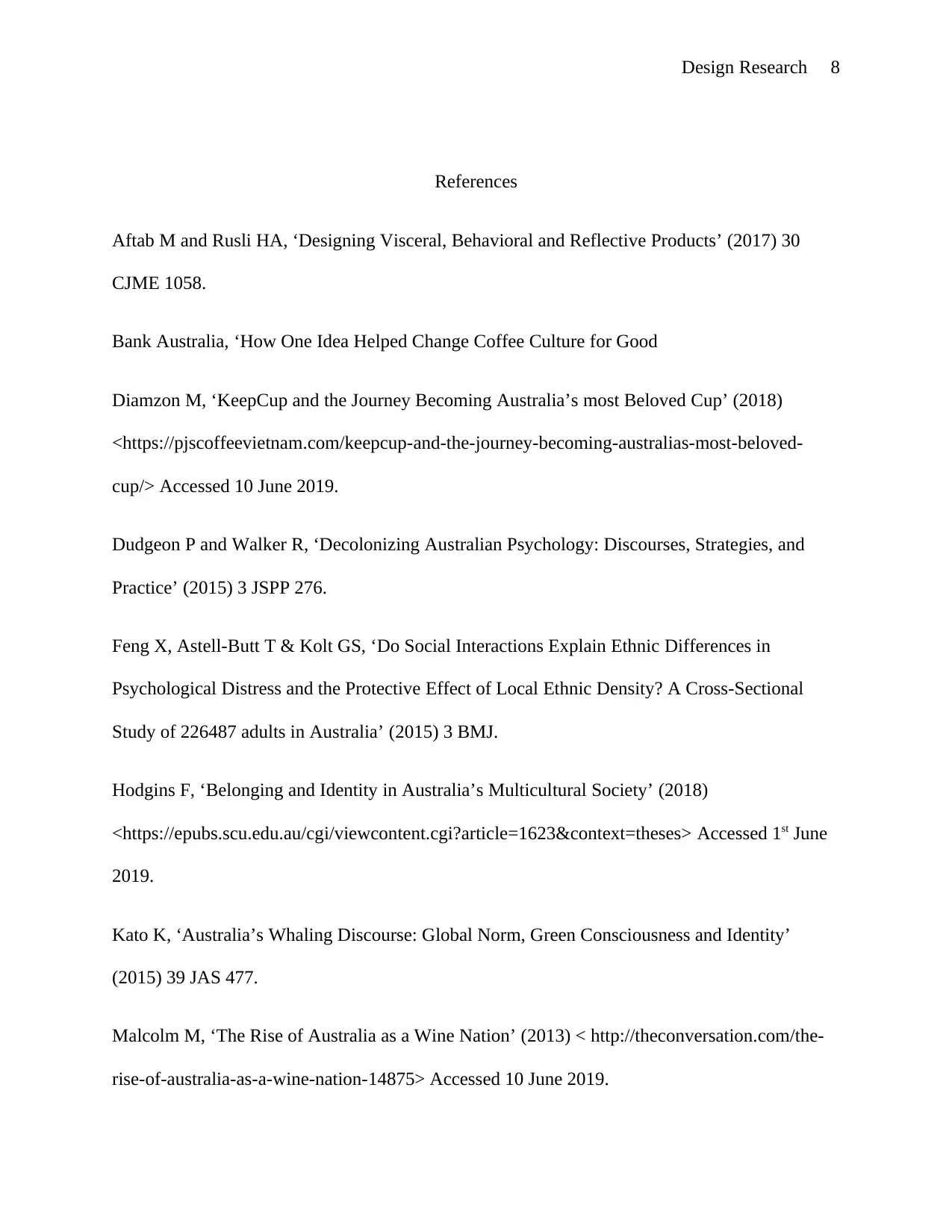
Design Research 8
References
Aftab M and Rusli HA, ‘Designing Visceral, Behavioral and Reflective Products’ (2017) 30
CJME 1058.
Bank Australia, ‘How One Idea Helped Change Coffee Culture for Good
Diamzon M, ‘KeepCup and the Journey Becoming Australia’s most Beloved Cup’ (2018)
<https://pjscoffeevietnam.com/keepcup-and-the-journey-becoming-australias-most-beloved-
cup/> Accessed 10 June 2019.
Dudgeon P and Walker R, ‘Decolonizing Australian Psychology: Discourses, Strategies, and
Practice’ (2015) 3 JSPP 276.
Feng X, Astell-Butt T & Kolt GS, ‘Do Social Interactions Explain Ethnic Differences in
Psychological Distress and the Protective Effect of Local Ethnic Density? A Cross-Sectional
Study of 226487 adults in Australia’ (2015) 3 BMJ.
Hodgins F, ‘Belonging and Identity in Australia’s Multicultural Society’ (2018)
<https://epubs.scu.edu.au/cgi/viewcontent.cgi?article=1623&context=theses> Accessed 1st June
2019.
Kato K, ‘Australia’s Whaling Discourse: Global Norm, Green Consciousness and Identity’
(2015) 39 JAS 477.
Malcolm M, ‘The Rise of Australia as a Wine Nation’ (2013) < http://theconversation.com/the-
rise-of-australia-as-a-wine-nation-14875> Accessed 10 June 2019.
References
Aftab M and Rusli HA, ‘Designing Visceral, Behavioral and Reflective Products’ (2017) 30
CJME 1058.
Bank Australia, ‘How One Idea Helped Change Coffee Culture for Good
Diamzon M, ‘KeepCup and the Journey Becoming Australia’s most Beloved Cup’ (2018)
<https://pjscoffeevietnam.com/keepcup-and-the-journey-becoming-australias-most-beloved-
cup/> Accessed 10 June 2019.
Dudgeon P and Walker R, ‘Decolonizing Australian Psychology: Discourses, Strategies, and
Practice’ (2015) 3 JSPP 276.
Feng X, Astell-Butt T & Kolt GS, ‘Do Social Interactions Explain Ethnic Differences in
Psychological Distress and the Protective Effect of Local Ethnic Density? A Cross-Sectional
Study of 226487 adults in Australia’ (2015) 3 BMJ.
Hodgins F, ‘Belonging and Identity in Australia’s Multicultural Society’ (2018)
<https://epubs.scu.edu.au/cgi/viewcontent.cgi?article=1623&context=theses> Accessed 1st June
2019.
Kato K, ‘Australia’s Whaling Discourse: Global Norm, Green Consciousness and Identity’
(2015) 39 JAS 477.
Malcolm M, ‘The Rise of Australia as a Wine Nation’ (2013) < http://theconversation.com/the-
rise-of-australia-as-a-wine-nation-14875> Accessed 10 June 2019.
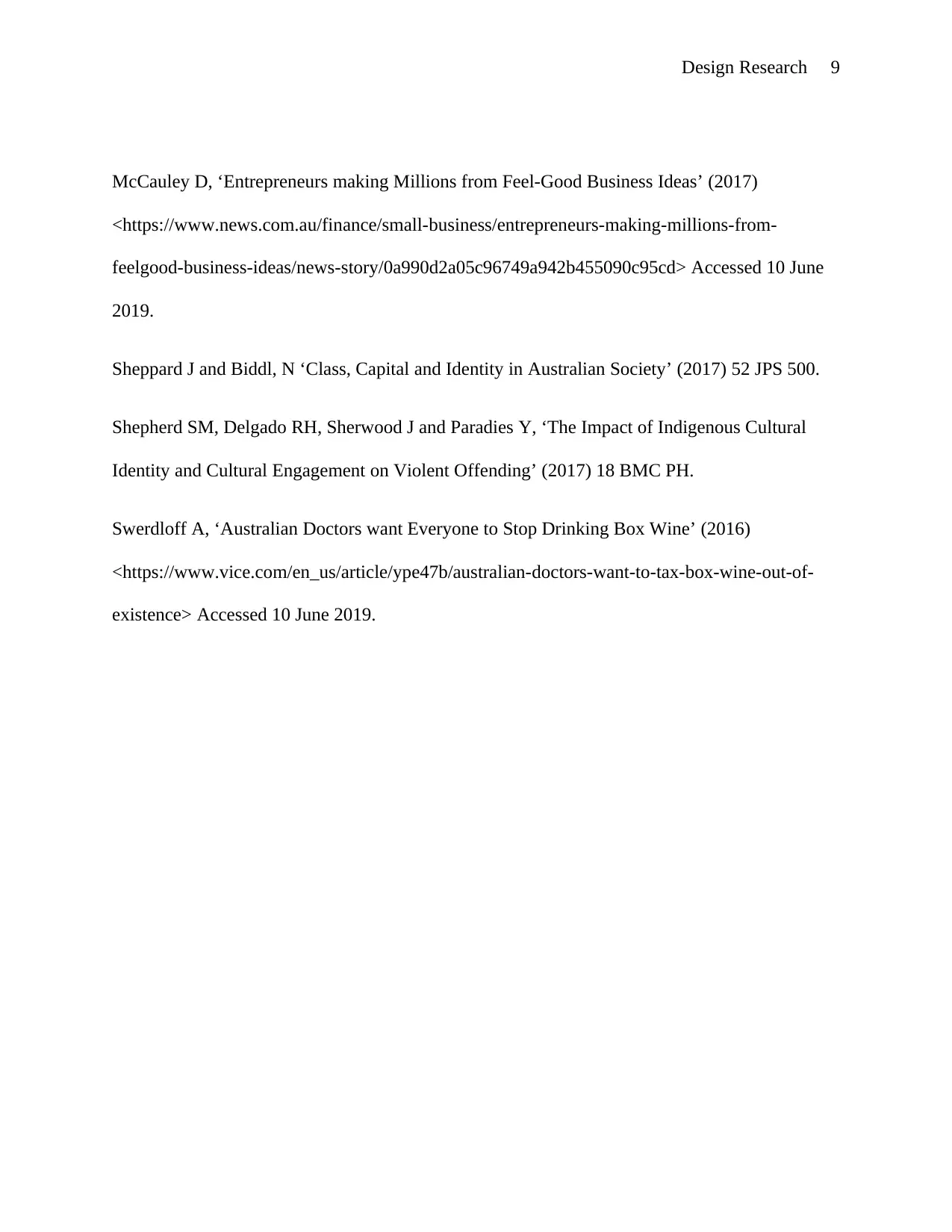
Design Research 9
McCauley D, ‘Entrepreneurs making Millions from Feel-Good Business Ideas’ (2017)
<https://www.news.com.au/finance/small-business/entrepreneurs-making-millions-from-
feelgood-business-ideas/news-story/0a990d2a05c96749a942b455090c95cd> Accessed 10 June
2019.
Sheppard J and Biddl, N ‘Class, Capital and Identity in Australian Society’ (2017) 52 JPS 500.
Shepherd SM, Delgado RH, Sherwood J and Paradies Y, ‘The Impact of Indigenous Cultural
Identity and Cultural Engagement on Violent Offending’ (2017) 18 BMC PH.
Swerdloff A, ‘Australian Doctors want Everyone to Stop Drinking Box Wine’ (2016)
<https://www.vice.com/en_us/article/ype47b/australian-doctors-want-to-tax-box-wine-out-of-
existence> Accessed 10 June 2019.
McCauley D, ‘Entrepreneurs making Millions from Feel-Good Business Ideas’ (2017)
<https://www.news.com.au/finance/small-business/entrepreneurs-making-millions-from-
feelgood-business-ideas/news-story/0a990d2a05c96749a942b455090c95cd> Accessed 10 June
2019.
Sheppard J and Biddl, N ‘Class, Capital and Identity in Australian Society’ (2017) 52 JPS 500.
Shepherd SM, Delgado RH, Sherwood J and Paradies Y, ‘The Impact of Indigenous Cultural
Identity and Cultural Engagement on Violent Offending’ (2017) 18 BMC PH.
Swerdloff A, ‘Australian Doctors want Everyone to Stop Drinking Box Wine’ (2016)
<https://www.vice.com/en_us/article/ype47b/australian-doctors-want-to-tax-box-wine-out-of-
existence> Accessed 10 June 2019.
⊘ This is a preview!⊘
Do you want full access?
Subscribe today to unlock all pages.

Trusted by 1+ million students worldwide
1 out of 9
Related Documents
Your All-in-One AI-Powered Toolkit for Academic Success.
+13062052269
info@desklib.com
Available 24*7 on WhatsApp / Email
![[object Object]](/_next/static/media/star-bottom.7253800d.svg)
Unlock your academic potential
Copyright © 2020–2025 A2Z Services. All Rights Reserved. Developed and managed by ZUCOL.





